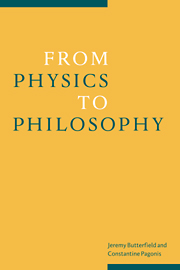Book contents
- Frontmatter
- Contents
- List of contributors
- Preface
- Introduction
- 1 Locality and the Hardy theorem
- 2 Beables in algebraic quantum theory
- 3 Aspects of objectivity in quantum mechanics
- 4 The ‘beables’ of relativistic pilot-wave theory
- 5 Bohmian mechanics and chaos
- 6 Strange positions
- 7 From metaphysics to physics
- 8 Models and mathematics in physics: the role of group theory
- 9 Can the fundamental laws of nature be the results of evolution?
- Bibliography of the writings of Michael Redhead
- Index of names
- Index of subjects
8 - Models and mathematics in physics: the role of group theory
Published online by Cambridge University Press: 23 December 2009
- Frontmatter
- Contents
- List of contributors
- Preface
- Introduction
- 1 Locality and the Hardy theorem
- 2 Beables in algebraic quantum theory
- 3 Aspects of objectivity in quantum mechanics
- 4 The ‘beables’ of relativistic pilot-wave theory
- 5 Bohmian mechanics and chaos
- 6 Strange positions
- 7 From metaphysics to physics
- 8 Models and mathematics in physics: the role of group theory
- 9 Can the fundamental laws of nature be the results of evolution?
- Bibliography of the writings of Michael Redhead
- Index of names
- Index of subjects
Summary
Introduction
The relationship between mathematics and science is clearly of fundamental concern in both the philosophy of mathematics and the philosophy of science. How this relationship should be represented is a crucial issue in this area. One possibility is to employ a model-theoretic framework in which ‘physical’ structures are regarded as embedded in ‘mathematical’ ones. In section 2 I will briefly outline a form of this type of account which offers a function space analysis of theories (Redhead 1975). This function space analysis is then used to represent the relationship between theoretical and mathematical structures. In subsequent sections I will consider the role of group theory in physics from within this meta-theoretical framework and then draw some conclusions for realism in the philosophy of science.
Function spaces and the model-theoretic approach
According to Redhead, it is an ‘empirical-historical fact’ that theories in physics can be represented as mathematical structures (Redhead 1975). This then allows the possibility of representing the relation of mathematics to physics in terms of embedding a theory T in a mathematical structure M′, in the usual set-theoretic sense of there existing an isomorphism between T and a sub-structure M of M′. M′ is then taken to be a non-simple conservative extension of M. There is an immediate question regarding the nature of T. To be embedded in M′ it must already be ‘mathematized’ in some form or other. Thus, the issue here is not so much Wigner's inexplicable utility of mathematics in science, in the sense of its being the indispensable language in which theories are expressed, but rather the way in which new theoretical structure can be generated via this embedding of a theory, which is already mathematized, into a mathematical structure.
- Type
- Chapter
- Information
- From Physics to Philosophy , pp. 187 - 207Publisher: Cambridge University PressPrint publication year: 1999
- 33
- Cited by

